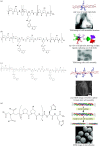Crafting of functional biomaterials by directed molecular self-assembly of triple helical peptide building blocks
- PMID: 29147553
- PMCID: PMC5665793
- DOI: 10.1098/rsfs.2016.0138
Crafting of functional biomaterials by directed molecular self-assembly of triple helical peptide building blocks
Erratum in
-
Correction to 'Crafting of functional biomaterials by directed molecular self-assembly of triple helical peptide building blocks'.Interface Focus. 2018 Aug 6;8(4):20180017. doi: 10.1098/rsfs.2018.0017. Epub 2018 Jun 15. Interface Focus. 2018. PMID: 29951195 Free PMC article.
Abstract
Collagen is the most abundant extracellular matrix protein in the body and has widespread use in biomedical research, as well as in clinics. In addition to difficulties in the production of recombinant collagen due to its high non-natural imino acid content, animal-derived collagen imposes several major drawbacks-variability in composition, immunogenicity, pathogenicity and difficulty in sequence modification-that may limit its use in the practical scenario. However, in recent years, scientists have shifted their attention towards developing synthetic collagen-like materials from simple collagen model triple helical peptides to eliminate the potential drawbacks. For this purpose, it is highly desirable to develop programmable self-assembling strategies that will initiate the hierarchical self-assembly of short peptides into large-scale macromolecular assemblies with recommendable bioactivity. Herein, we tried to elaborate our understanding related to the strategies that have been adopted by few research groups to trigger self-assembly in the triple helical peptide system producing fascinating supramolecular structures. We have also touched upon the major epitopes within collagen that can be incorporated into collagen mimetic peptides for promoting bioactivity.
Keywords: collagen; hierarchical self-assembly; supramolecular structures; synthetic collagen; triple helical peptides.
Conflict of interest statement
We declare we have no competing interests.
Figures








Similar articles
-
Collagen Mimetic Peptides.Bioengineering (Basel). 2021 Jan 5;8(1):5. doi: 10.3390/bioengineering8010005. Bioengineering (Basel). 2021. PMID: 33466358 Free PMC article. Review.
-
Peptide-triggered self-assembly of collagen mimetic peptides into nanospheres by electrostatic interaction and π-π stacking.J Mater Chem B. 2023 May 31;11(21):4677-4683. doi: 10.1039/d3tb00088e. J Mater Chem B. 2023. PMID: 37161598
-
Hierarchical Assemblies of Collagen-Mimetic Peptides: From a Fundamental Understanding to Developing Biomaterials.Langmuir. 2025 Apr 15;41(14):9162-9185. doi: 10.1021/acs.langmuir.5c00541. Epub 2025 Apr 4. Langmuir. 2025. PMID: 40184430 Review.
-
Terminal aspartic acids promote the self-assembly of collagen mimic peptides into nanospheres.RSC Adv. 2018 Jan 10;8(5):2404-2409. doi: 10.1039/c7ra11855d. eCollection 2018 Jan 9. RSC Adv. 2018. PMID: 35541475 Free PMC article.
-
Multi-hierarchical self-assembly of a collagen mimetic peptide from triple helix to nanofibre and hydrogel.Nat Chem. 2011 Aug 28;3(10):821-8. doi: 10.1038/nchem.1123. Nat Chem. 2011. PMID: 21941256
Cited by
-
Synthesis and Organization of Gold-Peptide Nanoparticles for Catalytic Activities.ACS Omega. 2022 Jan 6;7(2):2082-2090. doi: 10.1021/acsomega.1c05546. eCollection 2022 Jan 18. ACS Omega. 2022. PMID: 35071896 Free PMC article.
-
Biomimetic Remineralized Three-Dimensional Collagen Bone Matrices with an Enhanced Osteostimulating Effect.Biomimetics (Basel). 2023 Feb 23;8(1):91. doi: 10.3390/biomimetics8010091. Biomimetics (Basel). 2023. PMID: 36975321 Free PMC article.
-
Collagen Mimetic Peptides.Bioengineering (Basel). 2021 Jan 5;8(1):5. doi: 10.3390/bioengineering8010005. Bioengineering (Basel). 2021. PMID: 33466358 Free PMC article. Review.
-
Peptide framework for screening the effects of amino acids on assembly.Sci Adv. 2022 Jan 21;8(3):eabj0305. doi: 10.1126/sciadv.abj0305. Epub 2022 Jan 19. Sci Adv. 2022. PMID: 35044831 Free PMC article.
References
-
- Khan R, Khan M, Bey A. 2011. Use of collagen as an implantable material in the reconstructive procedures—an overview. Biol. Med. 3, 25–32.
Publication types
LinkOut - more resources
Full Text Sources
Other Literature Sources

